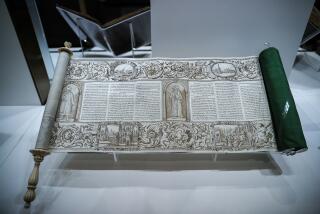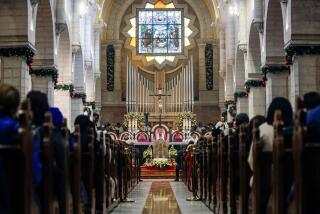Some Pilgrimage Places Resonate With Footsteps of History’s Holy Women
- Share via
Hannah Green, the author of “Little Saint,” thought that in certain special places “something in the conformation of the Earth has preserved since the earliest days the mysterious energy of God’s presence.”
Almost every faith has places that inspire pilgrimages. Most of the sites seem to be dedicated to male saints and sages. But pilgrims can find places associated with holy women if they seek them out.
The village of Conques in the rugged mountain and plateau country of south-central France lodged in Green’s heart because its 11th century church is dedicated to St. Foy. The “little saint” who inspired Green’s book converted to Christianity as a girl of 12, was turned in to Roman authorities by her father, refused to give up her faith and was martyred around 300.
Green was raised Episcopalian in Ohio. But in “Little Saint” she says that when she first saw the jeweled gold reliquary of St. Foy in the church’s treasury-museum, “I could feel the stirrings of that long procession of human beings who had come here down through time to fall on their knees and pray for her help, again and again in their devotion renewing her life, this eternal girl-child, daughter becoming woman, who held within herself the promise of all that is good and beautiful and healing.”
Green and her artist husband, Jack Wesley, also fell in love with Conques, which they discovered in 1975. The tough French country folk gradually accepted the Americans, and the medieval stone and half-timbered village, built above the gorge of the Ouche River, became the couple’s summer home. (They lived in New York the rest of the year.)
They routinely dined at the 17th century Hotel Sainte Foy and rode bicycles up the gorge and across the plateau to the north, noting vineyards, springs and prehistoric standing stones along the way. One summer they walked from Le Puy, 50 miles northeast, to Conques along the Via Podiensis, or pilgrim’s way, which ends in Santiago de Compostela in Spain, the shrine of the Apostle James.
Green’s book, which can serve as a pilgrim’s guide to Conques, lovingly describes the shiny gray schist houses of the town and how the Via Podiensis enters Conques through the Porte de Fumouze to the east and leaves through the Porte de Vinzelle to the west. The abbey church is at the center of town.
There the pilgrim must stop with Green to see its marvelously carved front, or tympanum, depicting the Last Judgment, with St. Foy praying for sinners and the devil trying to tip the scales of justice his way. In the treasury-museum, considered one of the finest in France, the reliquary statue of St. Foy holds pride of place, with, Green tells us, the bones of the martyr secreted inside.
I felt something of what Green felt there when I visited the church dedicated to St. Cecilia in Rome, built on the site where the patron saint of music was martyred in 230. And I’m now planning to make more trips to places that resonate with the lives and works of other holy women.
Rabbi Mimi Weisel of West L.A. says that Jews don’t make pilgrimages per se. “When we travel, especially to Israel, it is ... to be inspired, to learn, to immerse ourselves in history,” she says. One place she notes of special interest to Jewish women is the tomb of Rachel, wife of the patriarch Jacob, just outside Bethlehem, where she died in childbirth.
Mirabai, a 16th century Hindu holy woman who was born a princess in Rajasthan, India, turned her back on her palaces to devote her life to Krishna. She composed poems, danced and sang for the Hindu god and spent her time with religious ascetics and sages, so enraging her family that they tried to poison her. Eventually she left them to travel to the Krishna temple in Vrindavan, near New Delhi, where there is a temple that honors her.
When still a girl, she was married to a Rajput prince and sent to live in Chittorgarh, a fort that can still be visited, about 70 miles northeast of the beautiful city of Udaipur. From the 8th century to the 16th, Chittorgarh was the scene of sieges by Muslim invaders that often ended in defeat and death for Rajput warriors--and voluntary self-immolation for their wives (a custom at the time). When Mirabai’s husband died soon after their marriage, however, she refused to take her own life because, she said, she was married to Krishna.
Evelyn Underhill, who was born in England in 1875, was a different kind of holy woman, not a saint but the Anglican author of 39 books, including the influential “Mysticism,” published in 1911. As a girl she traveled widely with her parents in Italy, where the religious art and architecture moved her deeply. She spent most of her life England in an apparently placid marriage, but inwardly she struggled with her faith and yearned for a time to convert to Catholicism before she finally fully embraced Anglicanism in 1921 and came to see spiritual life as “simply a life in which all that we do comes from the center, where we are anchored in God.”
The Anglican retreat center beloved by Underhill is in the Essex hamlet of Pleshey, and her grave is at St. John’s Church in Hampstead, near London. She died in 1941, praised by many, including T.S. Eliot, who also struggled with his faith. In the poem “Little Gidding” he perfectly described why we go on pilgrimages, even if we aren’t religious.
“You are here to kneel/Where prayer has been valid,” he wrote, which holds true in Conques or Chittorgarh.
More to Read
Sign up for The Wild
We’ll help you find the best places to hike, bike and run, as well as the perfect silent spots for meditation and yoga.
You may occasionally receive promotional content from the Los Angeles Times.






